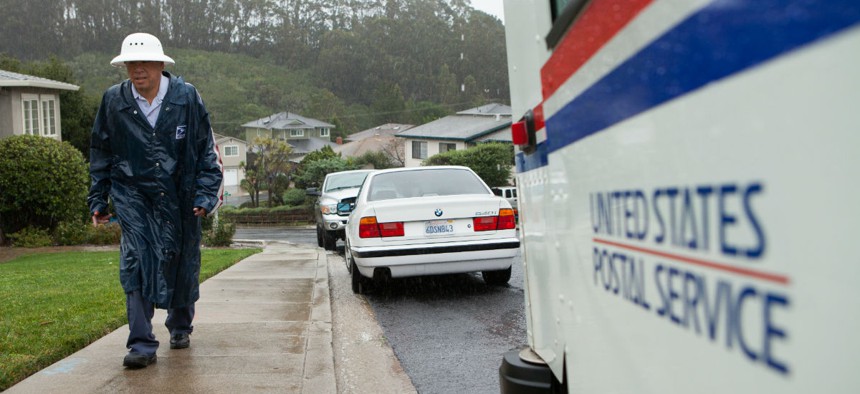
Alex Washburn / AP
USPS Has Shed 250K Employees in the Past 20 Years. Here’s How.
Way more cuts are expected in the next two years.
The U.S. Postal Service has used a variety of tools to shrink its workforce by nearly 30 percent in the last 20 years, as the struggling mailing agency has attempted to modernize and right size in a new era of communication.
A recently released report from the Congressional Research Service detailed the combination of attrition and separation incentives -- and, in one case, a round of layoffs -- the agency used to trim the number of people it employs by more than 250,000 since 1995. To further cut personnel costs, a “primary driver of USPS’ operating expenses,” CRS noted the Postal Service has increased its reliance on non-career employees.
Non-career workers serve in time-limited positions, but “can often perform the full range of duties of career counterparts at lower wage rates.” The employees generally receive some benefits, but are not eligible for federal life insurance or participation in the Federal Employees Retirement System.
Just between fiscal years 2011 and 2014, USPS grew the size of the non-career workforce by 46 percent to more than 125,000. Starting in fiscal 2011, USPS added three new non-career categories: postal support employees, city carrier assistants and mail handler assistants. Unions can bargain on behalf of those workers, who are eligible for raises, health benefits and leave.
Of course, the Postal Service’s shrinking workforce and increased reliance on non-career employees has stemmed from the dramatic decrease in Americans’ mail usage. As revenues dropped, USPS management turned to personnel costs -- which represented 78 percent of operating expenses in fiscal 2014 -- to bring the organization out of the red.
Between fiscal years 2010 and 2014, more than 55,000 postal employees accepted separation incentives ranging from $10,000 to $20,000 per person. Nearly all of the other job losses have stemmed from attrition: simply not filling a vacancy when an employee retires or leaves.
Former Postmaster General Patrick Donahoe repeatedly trumpeted the Postal Service’s ability to shrink its workforce without laying off employees. He said he took pride in that fact, once explaining, “Nobody else in this United States has been able to make this many changes with anywhere near the lack of negative impact on their employees.”
In 2015, however, after his successor and current Postmaster General Megan Brennan took charge, USPS did go through one brief round of layoffs. In January, after offering 3,000 postmasters a $10,000 buyout, USPS issued 249 reductions in force to employees who did not accept the incentive. The Postal Service offered all postmasters affected by the RIF the opportunity to work in part-time career positions.
USPS has said it may rely on layoffs “for the foreseeable future,” and last year hired a “RIF administrator.”
Many of the jobs shed by the Postal Service have been among city letter carriers, whose ranks have dropped off 31 percent over the last 20 years. Rural letter carriers have increased in that span, though they still make up a far less significant portion of the overall workforce. A decrease in mail volume and increase in automated functions have led to steep declines in the number of mail handlers and vehicle operators, CRS said.
Since fiscal 2007, USPS has averaged shedding about 32,000 jobs per year. CRS said it was “unclear” if the Postal Service will offer separation incentives going forward, though it will continue shrinking the size of its workforce. A USPS business plan updated in 2013 set the goal of employing just 404,000 employees by fiscal 2017. That would require a reduction of 84,300, or a cut of 17 percent, based on the workers on board at the end of fiscal 2014.
NEXT STORY: Farewell to a Giant of Government Oversight







